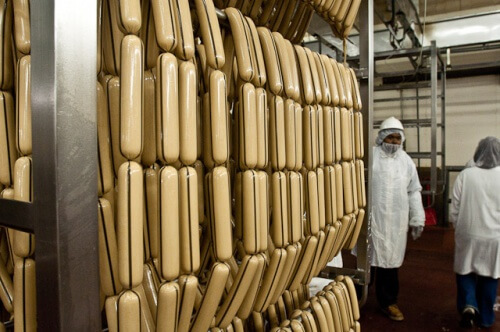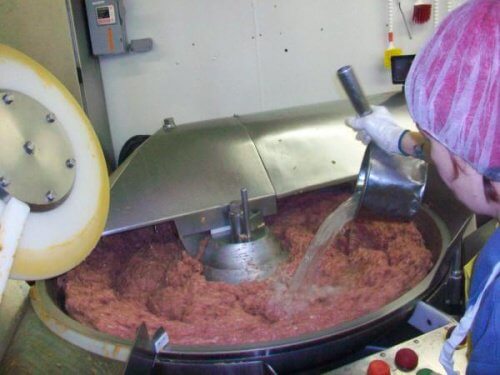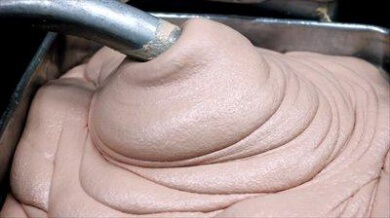Nitrite Additives in Hot Dogs are Carcinogenic


Reviewed and approved by the doctor Leonardo Biolatto
Nutritionists claim that certain additives in hot dogs can cause cancer. Different research carried out over recent years has shown some evidence of this. The consumption of hot dogs and especially the nitrite which they contain can post certain health risks, especially for young ones.
Facts about the consumption of hot dogs and certain diseases
So, what are these additives in hot dogs and how do they affect us?
One of the studies related the consumption of hot dogs and other similar foods with leukemia patients. They analyzed the diets of children from birth to 10 years old. Those that ate more than 12 hot dogs per month were nine times more likely to suffer from this blood disease.
And take note, because the risk was also present in the case of mothers who consumed at least 12 hot dogs per month before giving birth or during gestation.
On the other hand, a study carried out in the city of Denver, Colorado (United States), revealed that children whose mothers had eaten hot dogs at least once a week during pregnancy had double the risk of developing brain tumors, almost equal to those that consume this food regularly.

Why can additives in hot dogs cause cancer?
One of the main problems are the additives in hot dogs. They contain nitrites as preservatives, with the goal of combating botulism. When cooking hot dogs, these nitrites combine with other natural components of the meat and form carcinogenic compounds called n-nitroso.
It is also believed that the nitrites combine in the stomach and form the same substances, linking them with cancer of the bladder, brain, stomach, kidneys, esophagus and oral cavity. All “cured” meats contain nitrites, not just hot dogs. The same is true with hamburgers and bacon.
Likewise, not all hot dogs that we find in the market contain nitrites. You can tell which ones are full of this substance by the color of the food. If they are a bright red color (what we think of the color of fresh meat), then it is because they have used a lot of preservatives.
Hot dogs which are free of nitrites are those that have a light brown color or skin. However, do not be deceived, since some food manufacturers know how to combine other ingredients to make it appear as though their hot dogs don’t have so many nitrites.

Are there any hot dogs we can eat?
As a first step, it’s important to eat homemade hot dogs rather than the industrialized ones, such as the ones you can find on farms, at fairs and in some butcher shops. The industrialized ones are those found in shops and that come in sealed packages.
Furthermore, experts advise us not to eat more than 12 hot dogs a month, regardless of where you buy them. You can ask your local supermarket to sell a kind that is free from nitrites. You should also find out what kind are served for lunch at your children’s school.
It’s true that some vegetables also have nitrites (most of all those that are a green color such as lettuce, celery and spinach), however, the consumption of these vegetables reduces the risk of cancer.
This is possibly due to the fact that they don’t produce n-nitrosos even when boiled. Nitrites from vegetables are beneficial because they contain vitamins C and D which actually inhibit the production of n-nitrosos. Therefore they are not dangerous to our health, but actually just the opposite.
How are hot dogs made?
Maybe you are still curious about this food. Or perhaps the research carried out on nitrites has not yet completely convinced you. Perhaps you should also know just how hot dogs are made, and then afterwards you can choose whether to eat them or not.
This is one of the most consumed foods in all the world, and yet they house secrets which we really should know about. We are referring to the industrial kind, which are usually purchased in supermarkets and whose origin is so “risky.”
Doctors, nutritionists, scientists and investigators have all analyzed each one of the components that make up hot dogs. In other countries they go by the name of salchichas, sausages, panchos, frankfurters or Viennese. There are about 35 different types but we are referring to the classic “Vienna sausages.” Each one has its own characteristic aroma, texture, taste and above all, ingredients.

The ingredients and techniques that the majority of the brands, among the industrialized hot dogs, share are:
Mechanically separated meat
The meat in hot dogs is poultry and comes from different kinds of birds, especially chickens and turkeys. They pluck the birds and place them in a mechanical system that separates the bones from the meat.
Manufacturers can do this with cows and pigs too, but it is more difficult. In a microscopic analysis of the meat used in hot dogs, we can observe a variety of tissues and crushed bones, as well as nerves, cartilage, blood vessels, skin, etc.
See also: The WHO’s Findings on Meat and Cancer
Flavoring and water
The second main ingredient in hot dogs is water. Food regulations stipulate that at least 10% of each unit must be water. However, some brands contain up to 50%. We may think this is good for our health, however, the problem is not the water itself, but what they mix it with.
They dilute the artificial flavors in water, depending on the regulations of each particular country. These are chemical agents, essences or flavoring to make them spicier or add more flavor.
Salt and corn syrup
These two ingredients are present in large quantities in all fast food. In the case of corn syrup, it adds consistency, texture and a sweetness similar to homemade or traditional hot dogs.
On the other hand, salt (sodium chloride) is required for the manufacture, but often in excessive quantities. For example, a hot dog is almost 500 mg of salt, i.e. 20% of the recommended daily allowance.
Read more: Which types of salt are the healthiest?
Sodium phosphates and potassium lactates

Another of the additives in hot dogs is sodium phosphate, which is a mixture of sodium salts and phosphoric acid. In this specific case it interacts with the proteins (making them “useless”), to increase the juiciness and reduce water loss.
Regarding the potassium lactate, it’s a type of salt used as an acidity regulator and antioxidant. It is a meat preservative because it has antimicrobial properties (it kills harmful bacteria).
So, now you know everything about all the additives in hot dogs! It’s up to you to decide whether to eat them or not.
All cited sources were thoroughly reviewed by our team to ensure their quality, reliability, currency, and validity. The bibliography of this article was considered reliable and of academic or scientific accuracy.
- Adegbemiro B. Risk factors in street food practices in developing countries: A review. Food Science and Human Wellness. 2016; 5(3): 141-148.
- Eloi Chazelas, Fabrice Pierre, Nathalie Druesne-Pecollo, Younes Esseddik, Fabien Szabo de Edelenyi, Cédric Agaesse, Alexandre De Sa, Rebecca Lutchia, Stéphane Gigandet, Bernard Srour, Charlotte Debras, Inge Huybrechts, Chantal Julia, Emmanuelle Kesse-Guyot, Benjamin Allès, Pilar Galan, Serge Hercberg, Mélanie Deschasaux-Tanguy, Mathilde Touvier, Nitrites and nitrates from food additives and natural sources and cancer risk: results from the NutriNet-Santé cohort, International Journal of Epidemiology, 2022;, dyac046,
- Guerra Ramírez L. Cuantificación de sodio total en salchichas de consumo popular distribuidas en supermercados de la ciudad de Guatemala. Guatemala: Universidad de San Carlos, 2019.
- Karwowska, Małgorzata, and Anna Kononiuk. “Nitrates/nitrites in food—Risk for nitrosative stress and benefits.” Antioxidants 9.3 (2020): 241.
- Magee P, Barnes J. The production of malignant primary hepatic tumours in the rat by feeding dimethylnitrosamine. Br J Cancer. 1956; 10(1): 114-22. doi: 10.1038/bjc.1956.15.
- Palavecino Ferraro F; Palacio M. Determinación de la concentración de nitritos en salchichas tipo Viena de marcas comerciales. Tandil: UNCPBA, Facultad de Ciencias Veterinarias, 2017.
- Poppe Leaño C. Estandarización de la técnica para la determinación de nitritos en salchichas expendidas en mercados de la ciudad de La Paz. La Paz: Universidad Mayor de San Andrés, 2019.
- Segurondo Loza R, Lina Trigo O, Céspedes Valeros L. Vigilancia de nitritos y nitratos presentes en salchichas expendidas en los mercados: Rodríguez y Villa Fátima de la ciudad de La Paz. Rev. Cs. Farm. y Bioq. 2020; 8(1): 67-78.
- Villamil-Galindo, E. V. G., & Piagentini, A. M. (2021). El uso de Nitratos y Nitritos en la Industria cárnica, lo bueno, lo malo y el modelado matemático para optimizar su uso. Una revisión. Alimentos Hoy, 29(56), 41-76.
- Xie, L., Mo, M., Jia, H. X., Liang, F., Yuan, J., & Zhu, J. (2016). Association between dietary nitrate and nitrite intake and site-specific cancer risk: Evidence from observational studies. Oncotarget, 7(35), 56915.
This text is provided for informational purposes only and does not replace consultation with a professional. If in doubt, consult your specialist.








